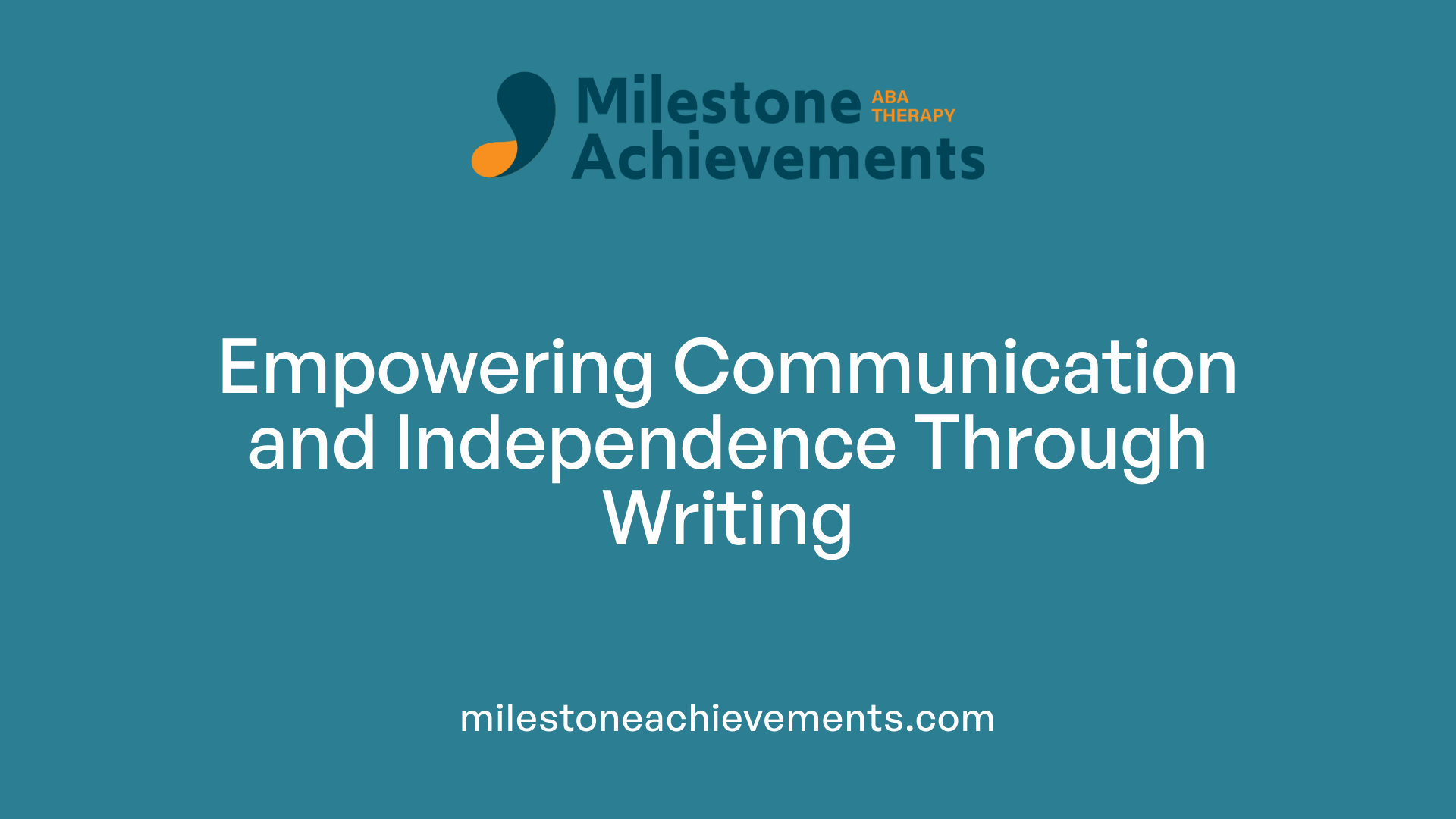Teaching Writing Skills to Autistic Students
Strategies and Supports for Developing Writing Skills in Autistic Students

Understanding the Foundations of Writing in Autism
Teaching writing skills to autistic students involves understanding their unique challenges and strengths. Early intervention focusing on pre-writing skills, incorporating visual supports, sensory activities, and structured routines can foster foundational abilities. By leveraging visual strengths and providing tailored accommodations, educators and parents can enhance engagement and progress in writing tasks, ultimately supporting students' communication, independence, and academic success.
The Importance of Developing Writing Skills for Autistic Students

Why is developing writing skills important for autistic students?
Developing writing abilities is vital for autistic children because it opens doors for effective communication, both in school and in everyday life. Writing helps them express their thoughts, feelings, and ideas clearly, fostering independence and social interaction.
Children on the autism spectrum often face challenges with fine and gross motor skills, which can make writing difficult. Early exposure to pre-writing activities like scribbling, drawing, and sensory play builds visual attention, motor coordination, and sensory awareness. These foundational skills are crucial for mastering letter formation and handwriting.
Using visual cues such as stickers, shapes, and graphic organizers can motivate students and guide their thinking processes. Incorporating sensory activities, like tracing in sand or clay, enhances memory for shapes and letters, making learning more meaningful.
Structured supports, including visual tools, assistive technology like typing, and routine activities, significantly benefit autistic learners. The use of special tools, such as the 'track changes' feature or a scribe, helps them revise and edit their work with less frustration.
Teaching strategies tailored to individual needs—such as clear checklists, social stories, and visual demonstrations—help students understand what is expected and stay engaged. As they develop, children progress from tracing and copying to independent writing of words and sentences, which boosts confidence.
Overall, fostering writing skills in autistic students boosts their communication abilities, supports academic success, and prepares them for future life challenges.
Effective Strategies for Teaching Writing to Autistic Students

What are effective strategies for teaching writing skills to autistic students?
Teaching writing to children on the autism spectrum requires a thoughtful and structured approach. One of the most effective methods is creating a stable, predictable environment. Using visual schedules and routines helps reduce anxiety and provides a clear framework for students, making it easier for them to focus on learning tasks.
Incorporating sensory supports can significantly aid students with sensory sensitivities that interfere with handwriting development. Activities like tactile tracing with sand, clay, or textured materials offer sensory-rich experiences that improve shape recognition and motor control. Additionally, sensory breaks, proprioceptive input, and calming activities help regulate sensory needs, ensuring children stay engaged.
Visual aids play a crucial role in teaching writing. Demonstrations, visual cues such as picture cards, and simplified instructions help children understand what to do. Breaking down writing tasks into smaller, manageable steps supports motor planning and makes the learning process less overwhelming.
Motivation is vital for sustained learning. Using reinforcement tools like visual charts, stickers, or small rewards can encourage progress. Consistent positive feedback boosts confidence and encourages continued effort.
It is also essential to customize instruction to meet individual needs. Collaborating with occupational therapists, integrating assistive technology like typing tools or speech-to-text programs, and setting personalized goals aligned with IEPs contribute to more effective learning experiences.
Overall, these strategies combine structure, sensory support, visual clarity, and personalization, creating an inclusive environment where autistic children can develop their writing skills more successfully.
Challenges Faced by Autistic Students in Developing Writing Skills
What challenges do autistic students often face in developing writing skills?
Autistic students frequently encounter several hurdles when it comes to developing strong writing skills. One major challenge is the difficulty with fine motor skills and visual-motor integration. These foundational skills are crucial for controlling a writing instrument and making deliberate marks, but many children with ASD may struggle with coordination and precision.
In addition to motor skills, characteristics of autism such as deficits in socialization, weak central coherence, and challenges with executive functioning can impact their ability to organize ideas, maintain coherence, and structure their writing effectively. These traits may make planning and revising texts particularly tough.
Communication impairments also play a significant role. Many autistic children have difficulties with expressive language, which can limit their ability to generate ideas or convey complex thoughts clearly in writing. This can affect their confidence and motivation to engage in writing tasks.
Despite these obstacles, some strengths—like a responsiveness to visual cues and an interest in technology—can be leveraged. Tools such as assistive software (e.g., First Author®) and visual supports like graphic organizers or social stories can help bridge these gaps. Structured routines, visual schedules, and the use of assistive technologies within frameworks like Universal Design for Learning can foster greater independence and enthusiasm in developing writing skills.
Understanding these challenges and applying targeted strategies can help educators assist autistic students in overcoming barriers and achieving success in their writing journey.
Practical Instructional Practices to Support Writing Development

What are some practical methods and instructional practices to support writing development in autistic students?
Supporting writing skills in autistic children requires a combination of visual aids, sensory activities, and hands-on practice. These approaches focus heavily on developing pre-writing skills such as drawing, tracing, and visual-motor coordination.
Using visual supports like graphic organizers, labeled diagrams, and visual cues helps children better understand the writing process and structure their thoughts. Incorporating sensory activities—such as tracing shapes in sand or clay—stimulates tactile senses, reinforcing shape and letter recognition and aiding memory.
Engagement plays a crucial role. Incorporating children’s interests through drawing or sensory play motivates them to participate. Rewards and positive reinforcement can boost confidence and sustain motivation during practice sessions.
Effective teaching strategies include modeling desired behaviors, breaking tasks into smaller steps through task analysis, prompting children with cues, and giving consistent praise to reinforce progress. These evidence-based practices foster independence and skill mastery.
Teachers should utilize a variety of tools to support learning. Pencil grips, slanted writing boards, and sensory supports like textured paper or fidget tools can make writing more comfortable. Visual cues such as stickers, shapes, and written instructions streamline task understanding.
Linking literacy activities across different settings—like integrating writing tasks into play or daily routines—enhances generalization and retention. Visual strategies like comic strips, story maps, and sentence frames enable children to generate ideas and organize their writing effectively.
Overall, combining these methods creates a supportive environment that adapts to the individual needs of autistic students, making the complex skill of writing accessible and engaging.
Using Evidence-Based Methods to Improve Writing Skills in Autistic Children
How can educators and parents improve writing skills in children with autism using evidence-based methods?
Enhancing writing skills in children with autism requires a combination of structured approaches and sensory considerations that cater to individual needs. Evidence-based strategies such as visual supports, task analysis, and explicit teaching methods like the POW Strategy (Pick one, Organize, Write) play a vital role. These methods break down complex writing tasks into manageable steps, making learning more accessible.
Implementing visual tools like graphic organizers, picture cues, and visual schedules helps children understand the sequence of writing activities and reduces anxiety. Assistive technology also offers valuable support — speech-to-text software, tablet apps, and electronic graphic organizers allow children to express ideas without the pressure of handwriting.
Activities that develop fine motor skills, including finger painting, squeezing stress balls, and hand strengthening exercises, enhance pencil grasp and control. Creating sensory-friendly environments equipped with appropriate seating, calming tools, and accessible writing materials ensures children stay focused and comfortable during lessons.
Personalized instruction is crucial. Learning plans tailored to each child's unique interests and sensory sensitivities encourage engagement and motivation. Regular assessments and collaboration with specialists, such as occupational therapists or speech-language pathologists, guide ongoing adjustments and support progressive skill development.
By combining these approaches, educators and parents can effectively support children on the autism spectrum to achieve meaningful growth in their writing abilities and foster greater independence in communication.
Pre-Writing Skills: Foundations for Writing Success
What are pre-writing skills and how can they be developed in autistic children?
Pre-writing skills are the fundamental abilities that set the stage for successful handwriting. These include activities such as drawing basic shapes, simple lines, and strokes, as well as developing fine motor control—like grasping a writing instrument and making deliberate marks.
For children with autism, fostering these skills involves engaging, sensory-rich activities that keep their interest. For example, children can practice making shapes in sand or finger-painting with modeling clay, which helps improve eye-hand coordination and motor planning. These activities make the learning process fun and meaningful.
Using visual supports plays a vital role in developing pre-writing skills. Visual schedules and timers help children understand routines and expectations, creating a structured environment that promotes patience and consistency. Visual cues like stickers or shapes can motivate purposeful movement, tracing, and copying tasks.
Imitation is also a useful strategy. Encouraging children to mimic gestures, actions, or simple social cues can enhance their communication skills, which are closely linked to writing development. Imitation activities can include copying facial expressions, hand movements, or gestures that promote engagement.
Collaborating with occupational therapists provides additional support. They can recommend personalized tools such as adapted grip pencils, sensory mats, or specific strategies tailored to each child's sensory preferences. These interventions aim to improve fine motor coordination and sensory regulation, directly supporting pre-writing skills.
In summary, developing pre-writing skills in autistic children involves a combination of engaging sensory activities, visual supports, imitation, and professional guidance. These foundational steps are essential for building the confidence and ability needed for more advanced writing tasks, setting children up for success in their literacy journey.
Tools and Worksheets to Support Autistic Writers

Are there specific tools or worksheets available to support writing in autistic students?
Yes, there are various designed tools and worksheets that help autistic children develop their writing skills effectively. These resources are tailored to suit their unique learning needs and motor development stages.
One common example is the use of specialized worksheets like Handwriting Without Tears, which simplifies letter formation and makes learning to write more accessible. Similarly, sight word tracing books focus on repetitive practice and visual recognition, helping children become more familiar with common words.
Visual aids are essential in breaking down the complex task of letter formation into manageable steps. Charts and diagrams can show how to form each letter correctly, often using colorful visuals that catch the child's interest.
Sensory tools play a significant role, especially for children who benefit from multisensory learning. Water paint books, magnetic tracing boards, and scratch-off activity books provide tactile and visual experiences that improve hand coordination, strengthen fine motor muscles, and enhance motivation. Magic drawing boards and clay-based activities can also help children practice shaping letters in an engaging way.
Assistive technology further supports writing skills. Software like First Author®, or simple digital apps designed for early learners, can enable children to practice letter formation and spelling through interactive, engaging methods. These tools often include features like highlighting, animation, and auditory cues that make learning lively and accessible.
Diversifying tools to align with each child's developmental level and individual interests enhances motivation and learning outcomes. For example, some children might prefer digital tools, while others thrive with tactile activities or visual aids.
Implementing these resources within a structured environment, with positive reinforcement, supports a child’s journey toward independent writing. Tailoring tools and approaches to the child's specific needs ensures a supportive, engaging pathway for acquiring essential writing skills.
| Tool Category | Examples | Benefits |
|---|---|---|
| Worksheets | Handwriting Without Tears, Sight Word Tracing | Simplifies letter learning, enhances visual recognition |
| Visual Aids | Letter formation charts, step-by-step diagrams | Clarifies letter shapes and sequences |
| Sensory Tools | Water paint books, Magnetic tracing boards, Scratch-off activity books | Strengthen fine motor skills, increase engagement |
| Assistive Technology | Writing software, Digital apps, 'Track Changes' in Word | Promotes independence, offers immediate feedback |
| Tailored Materials | Interests-based worksheets, Activities matching developmental level | Boosts motivation and personalized learning |
Offering a wide array of tools and worksheets, customized to each child's preferences and capabilities, creates a supportive environment for autistic children to develop their writing skills efficiently and confidently.
Understanding Why Many Autistic Students Find Writing Difficult

Why do many autistic students find writing difficult?
Autistic students often encounter challenges when it comes to writing, primarily due to difficulties with fine motor skills and visual-motor integration. These skills are crucial for controlling handwriting, which can result in inconsistencies in letter size, shape, and neatness. For example, children might struggle with controlling pencil pressure or maintaining proper letter spacing.
Beyond motor issues, many students with ASD face hurdles related to cognitive processing such as deficits in executive functioning. This affects their ability to plan, organize their thoughts, and sequence ideas effectively. Central coherence, or the ability to see the bigger picture, can also be weaker, making it hard to develop cohesive stories or essays.
Another area impacted is theory of mind, impacting perspective-taking and understanding characters’ feelings or motivations in creative writing. These social and cognitive traits can complicate understanding the purpose and structure of writing tasks.
However, research shows that visual supports are highly effective for these students. Tools like graphic organizers, comic strips, and visual checklists help break down complex tasks and make abstract concepts more concrete. These supports align well with the strengths of many autistic learners, who often process visual information more efficiently.
Assistive technology also plays a vital role in overcoming writing difficulties. Specialized software, typing tools, and visual organizational aids can reduce frustration and enable students to focus on content rather than handwriting mechanics.
Finally, leveraging students’ interests and intrinsic motivation through activities driven by their passions can boost engagement. When writing tasks relate to their hobbies or subjects they love, students are more likely to participate actively and develop their writing skills steadily.
Supporting Lifelong Communication Through Writing
Developing writing skills in autistic students is vital for their ability to express ideas, participate in academic and social contexts, and achieve independence. Effective teaching combines structured routines, visual supports, sensory strategies, and assistive technology with tailored interventions based on individual strengths and needs. Building these skills early and progressively ensures students can communicate more effectively, fostering confidence and opening pathways for future educational and life success.
References
- Autism and learning to write
- Helping Your Child with Autism Handwriting: 8 Strategies That Work
- 'What? You Want Me to Write It Again?!': Try these tips for teaching ...
- Improving the Written Expression of Children with ASD
- How teachers provide writing instruction to autistic students: A pilot ...
- Teaching Autistic Children Writing Skills - Blog
- Handwriting and the Autism Spectrum
- Children with autism show specific handwriting impairments - PMC







